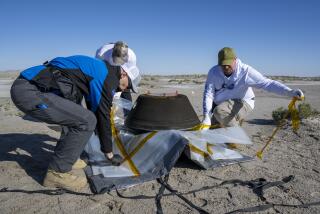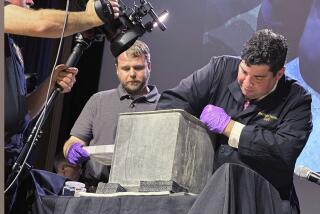A Way to Leave a Legacy for Future Generations
- Share via
Keeping up with the times, Larry and Caroline Rober of Brea turned to the Internet to satisfy their need to make a mark in the new millennium--and bought their time capsule, online.
The glistening, stainless steel tube--nearly a foot long, 3 1/2 inches in diameter and carrying a price tag of around $27--will be packed with mementos and letters to their children and then stored in an attic trunk until the couple dies. Caroline Rober said she learned the value of such items from her grandmother.
Among the belongings handed down was her grandmother’s key chain. “It’s part of her that’s with me and it reminds me of all the wonderful things she taught me and how she loved me,” Rober said. “Someday my children or great-grandchildren will want that feeling of security and being connected.”
Experts say similar feelings, and the advent of 2000, have prompted thousands of families to join schools, companies and other institutions in preparing similar messages and keepsakes for the future.
Time capsules are experiencing a boom as the millennium gets ready to close. They come in forms as homemade as two toilet bowls clamped together or a coffee can buried in a backyard. They can be as elaborate as an enormous polymer container tucked into a building’s cornerstone.
Purists scoff that many capsules being used are cheap substitutes that will not protect their contents very far into the future. A coffee can, for example, will quickly rust apart, they say. But no one denies their appeal.
“Time capsules spring from the urge to propagate the self,” said Gregory Benford, a UC Irvine physics professor, science fiction writer and author of the book “Deep Time: How Humanity Communicates Across Millennia.”
There’s something primal about leaving a mark, according to Paul Hudson, founder of the International Time Capsule Society, located at Oglethorpe University in Atlanta.
“Any kid who has buried treasure understands that,” he said. “Anyone who has stuck one’s hand in wet cement would know the feeling. It’s the sense of immortality.”
Time capsules give future generations a glimpse of the achievements, dreams and trivia of a society. Barbie dolls, condor feathers, embalmed fish, Twinkies and a “Buns of Steel” videotape are among the items put into various time capsules nationwide in recent years, Hudson said.
One capsule buried in Tucson, Ariz., in 1950 contained a Chevrolet--with a full tank of gas.
About 20,000 capsules are buried in the world, according to the time capsule society, with which enthusiasts can register their time capsules. That figure does not include the unofficial and unregistered communiques to the future.
Though no one can say how many time capsules are being sealed this year, experts point to an explosion of offerings on the Internet and in retail stores as evidence that relics are being packed away at an unprecedented pace.
“I’ve been following time capsules for 20 years, and there’s a big surge on the Internet right now,” said John Mallory, a San Francisco Bay Area-based time capsule consultant.
Official millennium-themed capsule ceremonies--including the unveiling of a national time capsule at the White House on New Year’s Eve--are planned by the hundreds across the nation.
Experts say time capsules in this country can be traced to George Washington, who embedded one of the first recorded capsules in the cornerstone of a Philadelphia building.
The term “time capsule” was coined in 1938 at the New York World’s Fair. That capsule, designed for long-term preservation--5,000 years--was sunk into a special “time well” dug into the Earth. The glass-lined, hydrogen-filled copper-alloy cylinder contained 1,000 photos, a can opener, a woman’s hat, safety pins and sheet music to “Flat-Footed Floogie.”
Interest in time capsules typically grows in anniversary years, said expert Hudson. It swelled with the Bicentennial in 1976 and again in 1992, the 500th anniversary of Christopher Columbus’ arrival in the New World.
Although today’s capsule aficionados may be tempted to squirrel away information stored on CDs or floppy discs, experts say the contents must be interred with an eye to the distant future--when existing technology may be extinct.
Notes written with a No. 2 pencil on acid-free paper may be the best-preserved records, said Benford.
The Internet has proven a fertile ground for businesses hoping to make money on the craze. Many Internet companies are hawking time capsules ranging from $20 to $750.
One Web page promises virtual immortality: “Leave your mark on the future. Be a part of history,” it reads.
“Imagine someone--a kid, or a future archeologist, or an alien being--unearthing your time capsule in 100 years, 1,000 years, or 1,000,000 years from now. . . . And these future people will study your trinkets from the past--a crumbling newspaper, a penny, your birthday photo, a lock of your hair--and they will learn that little bit more about us.”
Experts say that one need not spend a fortune to save relics for the future. An investment of less than $30 will buy the respectable kind of capsule used by the Rober family, and even a Coke bottle sealed with wax will do.
Hudson said he knows of cedar chests and potato chip cans being used as time capsules.
“We’ve even heard of coffins being used as time capsules,” he said. “Certainly it would preserve artifacts, but it might detract from the festive nature of the ceremony.”
More to Read
Inside the business of entertainment
The Wide Shot brings you news, analysis and insights on everything from streaming wars to production — and what it all means for the future.
You may occasionally receive promotional content from the Los Angeles Times.










